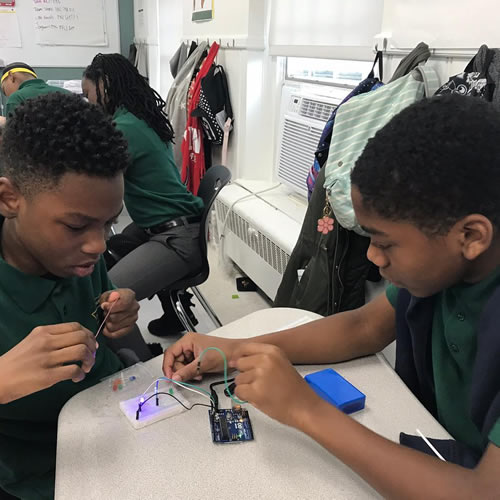There’s a widening technology achievement gap for minorities, despite blacks and Hispanics having more interest in learning computer science. So why is the field so dominated by whites?
eSchool News recently spoke with Mashea Ashton, who founded Washington, D.C.’s first computer science middle school last year in a struggling, historically black community to help bridge the technology achievement gap. Today, 99 percent of the students at Digital Pioneers Academy (DPA) are on a free lunch program. Ashton, who previously worked with Senator Cory Booker to create more educational options in Newark, N.J., talked about how innovative educators can help solve the racial achievement gap.
eSN: There are lots of cities with impoverished neighborhoods and poor public school systems, so why did you choose to start DPA in southeast D.C.?
Ashton: My husband’s family goes back six generations in southeast D.C. and I taught here early in my career. Southeast Washington, D.C.. is a unique and multifaceted community, where the talent pool is high, but access to transformational educational opportunities is often lacking. I love my community and know that our students can achieve anything they set their minds to accomplish. I saw DPA as a way to bridge the achievement and opportunity gap for scholars east of Washington D.C.’s Anacostia River, and for people of color who are disproportionately underrepresented in the technology field.
eSN: With your first year almost completed, what are some challenges you’ve encountered this year that you didn’t expect when DPA was starting?
Ashton: I’ve been working in public education for nearly 20 years, so not much surprised me when we opened DPA last year. One component of working with middle school students that continues to push my thinking around the work we are doing is the challenges and obstacles our scholars face outside of school. Some of our students have to carry adult responsibilities or have experienced trauma outside the classroom. I am constantly reminded of the importance of addressing the social-emotional needs of our scholars in an effort to achieve our academic goals.
eSN: How would you grade DPA on integrating computer science (CS) education into the curriculum this year? What makes DPA’s CS curriculum unique?
Ashton: Many believe that CS is simply too hard to teach, and believe you need very specific expertise in the field just to teach it at a K-12 level. DPA takes a non-expert-dependent approach to our CS curriculum: Our teachers come in with little to no background in the subject and the curriculum allows teachers to learn skills through projects before scholars. Both students and teachers start learning basic programs like Scratch before diving into the big coding languages like CSS and Javascript.
eSN: As you know, the tech field is largely dominated by men, while women and other demographics are not finding the same success in the field. What are you doing at DPA to include these groups of students?
Ashton: For us, it started with our name. We chose the name Digital Pioneers Academy because “pioneer” doesn’t suggest any specific gender or race. Leaders and innovators come from all kinds of backgrounds, just as our students and teachers do. In fact, girls make up more than half of our student body. While our faculty is diverse, we hire based solely on alignment with our mission and values. It’s important that our students know that no matter what their skin color or background, they know that if they believe in themselves and put in effective effort they can achieve their goals.
eSN: D.C. has a booming tech sector, with companies like Amazon choosing to move there over other big cities. As DPA expands its grade levels, do you have plans to establish relationships with any of these companies?
Ashton: We’re already partnering with Microsoft and Deloitte to give our students opportunities to work with leaders in the tech industry and expose them to the kind of careers they could enter in a few years after college. We are trying to create more opportunities for our students to take part in “expeditions,” where they are exposed to tech careers in which they can apply what they are learning in the classroom. They might get to show off their skills to experts from these companies and then tour the companies’ offices to see their work up close. We think it’s important for our scholars to experience these environments in person so that the prospect of high achievement after graduation becomes something tangible.
eSN: Where do you hope to see DPA in 20 years? Are you planning any new projects/school startups for the future?
Ashton: Our plan is simple: to be the most innovative school in America. We want to close the achievement and opportunity gap for low-income and working-class students of color.
We hope that DPA equips all our students to enter higher education and eventually the job market, where they can secure in high-paying careers. With more high-quality college-prep schools that prepare students for the digital economy, we believe we can help break the cycle of poverty in areas like southeast D.C. In the coming years, we hope to open up to 25 DPA schools in cities across the country. We are creating an educational model that allows for schools to be tailor-made for their communities and totally replicable in new areas.
- Why we love our PD tools - May 13, 2019
- How one middle school is closing the technology achievement gap - May 10, 2019
- How STEM learning invigorates classrooms - May 1, 2019

